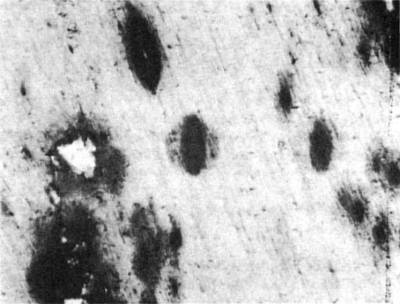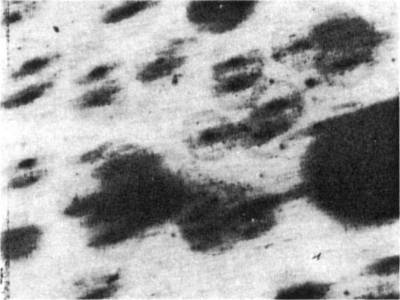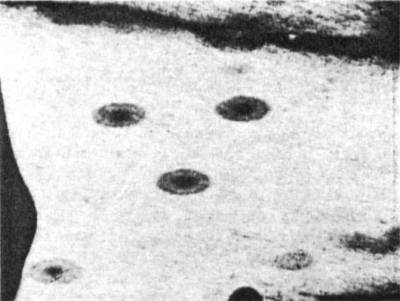|
Earth Science Associates |
|||||||||||
|
||||||||||||
|
Creation's Tiny Mystery |
||||||||||||
|
|
< Prev T of C ... 12 13 14 15 Epi. Cat. App. Ref. Cred. Next > Secondary Radiohalos in Coalified WoodAll the various types of halos discussed thus far are termed primary halos because they developed from alpha radioactivity emanating from small accessory inclusions that were present when the mineral crystallized. But secondary halos also exist in pieces of coalified wood taken from highly uraniferous deposits in the Colorado Plateau. There is abundant evidence that U solutions infiltrated much of the sedimentary material in the geological formations of that region when the wood was still in a gel-like condition (17). When U-bearing solutions passed through pieces of wood, certain active sites within these specimens preferentially collected U, other sites collected rare earth type elements, and still others Se, Po, and Pb. It is quite significant that the U halos, which developed around the tiny U-rich sites, are all underdeveloped, which, on the [p. 275] basis of a uniform decay rate (the rationale for using this assumption for these specimens will be explained subsequently), suggests only a relatively short time since U infiltration. Ion microprobe mass scans of these U halo centers have shown extremely high 238U/206Pb ratios, which, again on the assumption of a uniform decay rate, is consistent with a U infiltration within the last several thousand years (17).
Similar underdeveloped U halos have been found in the coalified wood from the Chattanooga Shale, and in fact recent ion microprobe analyses show, in agreement with earlier results (17), that the 238U/206Pb ratios of the U halos in the Colorado Plateau samples (Eocene, Triassic, and Jurassic) and the Chattanooga Shale (Devonian) are virtually indistinguishable. These results suggest that U-infiltration occurred concurrently in all these formations. Another class of more sharply defined halos was also discovered in the Colorado Plateau coalified wood specimens (17). The centers of these halos exhibit a distinct metallic-like reflectance when viewed with reflected light. Three different varieties of this halo exist: one with a circular cross section, another with an elliptical cross section with variable major and minor axes, and a third most unusual one that is actually a dual halo, being a composite of a circular and an elliptical halo around exactly the same radio-center (see Figs. 4-6). Although the elliptical halos differ radically from the circular halos in minerals, the circular type resembles the 210Po halo in minerals and variations in the radii of circular halos approximate the calculated penetrated distances (26 to 31 μm) of the 210Po alpha particle (energy E = 5.3 MeV) in this coalified wood (17). Henderson (18) theorized that Po halos might form in minerals when U-daughter Po isotopes or their alpha precursors were preferentially accumulated into small inclusions from some nearby U source. This hypothesis has not been confirmed for the origin of three distinct types of Po halos in U-poor minerals (1,2,11), but it does seem to provide a reasonable explanation for the origin of 210Po halos in U-rich coalified wood specimens. Electron microscope x-ray fluorescence analyses showed these halo centers were mainly Pb and Se. This composition fits well into the secondary accumulation hypothesis for both of the U-daughters, 210Po (half-life, t½ = 138 days) and its beta precursor 210Pb (t½ = 22 y), possess the two characteristics that are vitally essential for the hypothesis: (i) chemical similarity with the elements in the inclusion and (ii) half-lives sufficiently long to permit accumulation prior to decay, a requirement related to the nuclide transport rate. What is the meaning of the 210Po halos in Figs. 4-6? Clearly, the variations in shape can be attributed to plastic deformation which occurred prior to coalification. Since the model for 210Po formation thus envisions that both 210Po and 210Pb were accumulating simultaneously in the Pb-Se inclusion, a spherical 210Po halo could develop in 0.5 to 1 year from the 210Po atoms initially present and a second similar 210Po halo could develop in 25 to 50 years as the 210Pb atoms more slowly beta decayed to produce another crop of 210Po atoms. If there was no deformation of the matrix between these periods, the two 210Po halos would simply coincide. If, however, the matrix was deformed between the two periods of halo formation, then the first halo would have been compressed into an ellipsoid, and the second would be a normal sphere. The result would be a dual "halo" (Fig. 6). The widespread occurrence of these dual halos in both Triassic and Jurassic specimens can actually be considered corroborative [p. 276] evidence for a one-time introduction of U into these formations, because it is then possible to account for their structure on the basis of a single specifically timed tectonic event (17).
Doc.: T of C ... #13 #14 #15 #16 #17 #18 #19 #20 #21 ... < Prev T of C ... 12 13 14 15 Epi. Cat. App. Ref. Cred. Next > |
|
|||||||||
|
|
||||||||||||
|
||||||||||||
|
Earth Science Associates
|
||||||||||||





